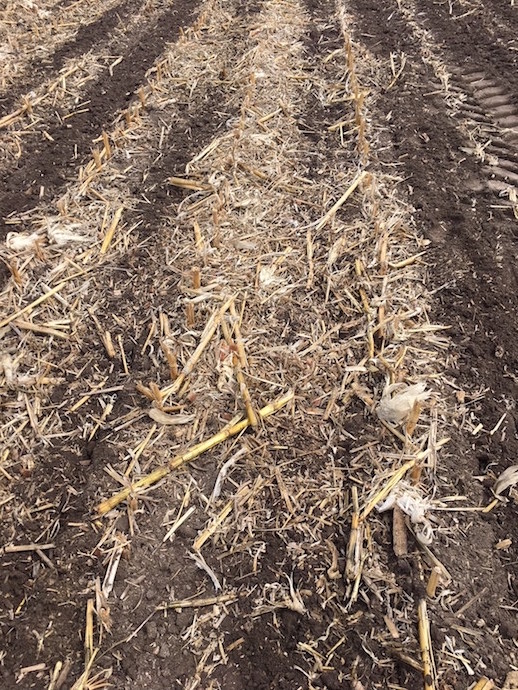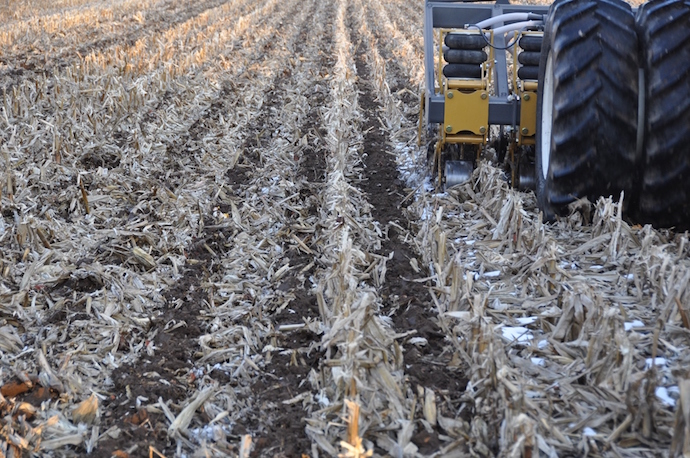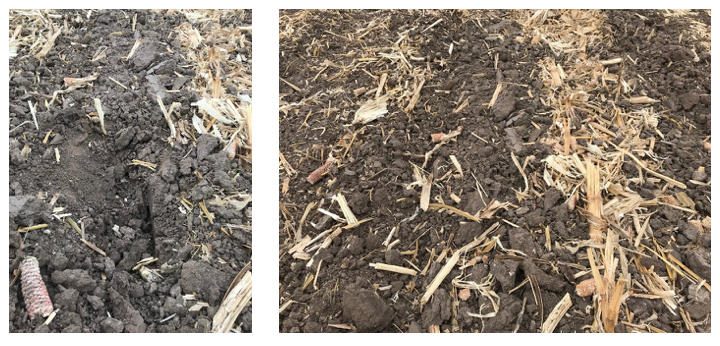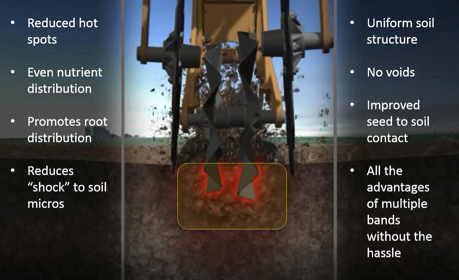By Eric Moore, ETS Agronomist
At Environmental Tillage Systems we often get the question, “What should my strip-tilled zones look like?” The aspects I evaluate in a strip-tilled zone include: residue management, soil structure and nutrient placement.
- Residue Management — Have we moved enough residue to allow the soils to warm up uniformly, and to eliminate hair pinning seeds into residue during planting?
- Soil Structure — Is our strip-till operation yielding a soil free of air pockets and voids with a uniform structure to give us consistent seed to soil contact?
- Nutrient Placement — And are we placing our nutrients where they will be available to the crop in a manner that promotes good root development?
Residue Management
Residues are important to crop production in many geographies because they reduce erosion (wind and rain), capture beneficial moisture during periods of snowfall, reduce evaporative moisture losses during the growing season and improve water infiltration rates. Studies from Kansas State University indicate that leaving crop stover on the soil surface can reduce evaporative losses during the growing season by up to 4½ inches, leaving additional moisture available to the crop during grainfill (Klocke, 2005).
However, residue can create some challenges to crop production if not managed properly including cold, wet soils, poor seed-to-soil contact, and reduced nutrient availability. Soil temperatures are up to 10 degrees F colder where residues are covering the soil than the tilled zones where residues have been removed. Additionally, planting into heavy residues can position seeds in direct contact with residue, or “hair pinned.” This can lead to poor germination, uneven emergence and to an increased incidence of seedling disease.
Another residue challenge is reduced nutrient availability through fertilizer tie-up and cold soils. Nutrients placed on old crop residues are often not available to the growing crop and are at risk of being lost due to residue movement off the field from wind and rain. Also, nutrient availability is negatively impacted by cold soils. For example, phosphorous is four times less available in a 58-degree F soil than it is in a 70-degree F soil.
- Read the full article on residue management here: 4 Considerations for Strip-Till Residue Management >>
Here’s an example of poor residue management. Residue is not evenly distributed throughout the field nor is it cleared from the seedbed:

Good residue management is shown in the following photo:

Soil Structure
Creating a uniform soil structure is important for even crop emergence. Corn seeds begin the germination process once they have imbibed 30-50% of their weight in water. If the soil in our tilled zone does not have a uniform structure, or has air pockets and voids, those seeds likely will not contact the soil uniformly. For each planted seed to take in water at the same rate, they must each be in full contact with the soil. Plants that emerge late become runt plants and suffer up to a 50% reduction in yield potential due to reduced availability to sunlight and nutrients.
Poor soil structure created during a strip tillage operation can adversely impact the planting depth. Planting seeds too shallow can reduce root development. A reduction in root development can lead to poor nutrient uptake, reduced drought tolerance and even yield losses greater than 40% due to root lodging.
The following zones are not ideal. The shank left voids and slabbed soils, which will impact stand establishment:

The following zones are ideal. The strip-tillage equipment created zones that are uniform, allowing evenly-timed germination, which will lead to good crop emergence and stand establishment:

Nutrient Placement
Fertilizer placement during the strip-till operation is another aspect that should be given close attention. Placing all our nutrients in a concentrated band too close to the seed can increase the risk of salt injury to germinating seeds. However, placing the nutrient band too deep can delay nutrient uptake and potentially leave mobile nutrients at risk for additional leaching in light-textured soils. Additionally, if your soils are very low in nutrients, a deep-placed concentrated band may result in stratification of nutrients and be detrimental to overall root development. Be sure your nutrient placement method creates a zone of fertility encompassing the full root zone of the growing plants.
- Read the full article on zone fertility placement here: Banding vs. Zone Fertility Placement >>
The benefits of zone tillage and nutrient placement are shown in the following graphic.

The Ideal Zone
Residue management, soil structure and nutrient placement are the three keys to creating the ideal strip-tilled zone. Ensure your zones are relatively free of residue before planting to allow soils to warm properly and to improve seed-to-soil contact. Monitor zones throughout your strip-tillage operation for voids or slabbed soils. A uniform soil structure throughout the zone is ideal for even crop emergence. Finally, I encourage you to observe nutrient placement and make adjustments if needed to create a zone of fertility that encompasses the entire root growth area.
If you manage your prior crop residues, select the strip-till implement that gives you the best prepared seedbed, and place your nutrients where they are best utilized by the growing crop, you will set yourself up for a successful start to the summer growing season.
References
Klocke, N. L. (2005). Crop Residue and Soil Water Evaporation. Kansas State University.
All photos courtesy of Environmental Tillage Systems, Inc.





